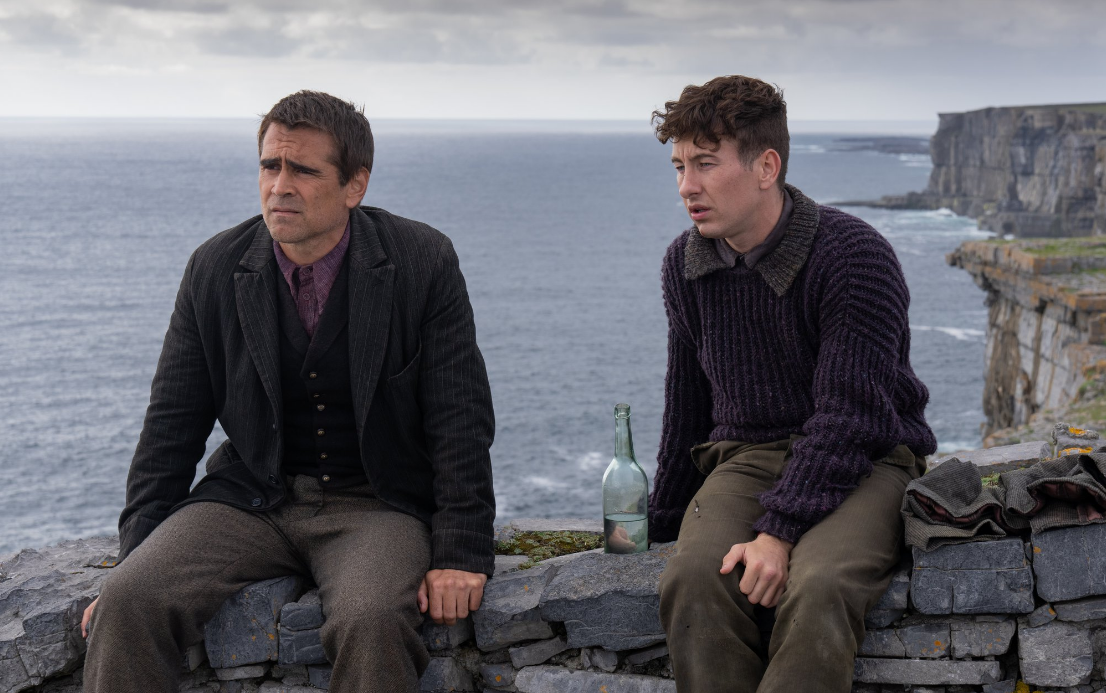(Martin McDonagh, 2022, Ireland/UK/USA, rated R, 114 minutes)
Inisherin is the kind of postcard-pretty Irish town that only really exists in the imagination of filmmakers like Martin McDonagh. It isn't just that his film takes place in a past devoid of radios and TV sets--even electricity--but Inisherin is more of an idea of Ireland than a representation.
In its hazy beauty, it never looks or feels quite real, though McDonagh, an Englishman of Irish ancestry, filmed on location on the Aran Islands (aided by extensive post-production work to erase all signs of modernization).
Though I don't believe he was aiming for documentary realism, his take on rural Ireland isn't worlds away from the cozy communities depicted in mainstream features, like Kirk Jones's 1998 codger comedy Waking Ned Devine or John Patrick Shanley's 2020 romantic picaresque Wild Mountain Thyme (from his play Outside Mullingar). I doubt that McDonagh, a playwright who expanded from the stage to the screen with his Oscar-winning 2004 short Six Shooter, would be flattered by those comparisons.
As a filmmaker, his work often feels like a cross between the plays of Samuel Beckett and David Mamet and the films of Quentin Tarantino.
The 27-minute Six Shooter with Inisherin actor Brendan Gleeson features a reported 34 instances of the word fuck and its variants. That's something the American auteurs behind 1992's Glengarry Glen Ross and Reservoir Dogs could get behind--and probably inspired. (According to Jason Bailey's recent 30th anniversary piece about both films in The New York Times, one features 138 instances of the word and the other features 269.)
The Irish-born Beckett, meanwhile, is famed for work that is stripped to the bone. Plays like Waiting for Godot could be set in Ireland, or anywhere, really. They exist in minimalist spaces of the writer's unique imaginings.
Inisherin, by contrast, can be cartoonish. Other than Kerry Condon's Siobhán, the characters are a pretty simple-minded lot. With few exceptions, they aren't all bad or all good, but they're painted with broad strokes.
Colin Farrell's Pádraic, a dairy farmer, shares a cottage with Siobhán, his well-read sister. Pádraic considers Siobhán, Colm (Brendan Gleeson), and Jennie, a donkey, his closest companions. There's no mention of parents or partners, love or sex, but Pádraic has everything he needs. Or so he thinks.
That changes when Colm stops talking to him and Siobhán considers leaving for a teaching job. There's also the buzz of war in the distance. Though McDonagh doesn't specify the year or the conflict, characters make vague references to it (it's 1923 and civil war is in full bloom). They know something is going on, but they're more concerned about life on Inisherin, where minor conflicts, like Colm's silent treatment, can seem cataclysmic.
Though it's tempting to describe the 20-year age gap between Pádraic and Colm as unrealistic, cross-generational friendships aren't completely unheard of. If anything, I wish they were more common, but in an isolated village like Inisherin, Pádraic doesn't have many options (in 2008's In Bruges, the actors' first collaboration with McDonagh, Gleeson played more of a protective mentor figure to Farrell's trigger-happy hitman).
Though Pádraic has a friendly rapport with the troubled, puppyish Dominic (The Green Knight’s jittery Barry Keoghan), they aren't exactly friends.
If anything, Colm's age seems a likely factor in his desire to concentrate on his fiddle-playing over his pub sessions with the amiable, if aimless Pádraic.
In a different kind of movie, Colm's behavior might signify mental illness--not least when he turns to self-mutilation after Pádraic refuses to leave him alone--but McDonagh presents both men as stubborn in the worst of ways.
The more closed-off Colm becomes, the more aggressive Pádraic becomes in trying to get him to open up. He just wants things to return to the way they were, but once the Spy vs. Spy trajectory is set in motion, it's too late.
Though described as a black comedy, and studded with some genuinely amusing bits of business, Inisherin's central conflict, a metaphor for the Troubles, plays more like tragedy. The actors are certainly up to the task, though the Venice Film Festival awarded Farrell for his work over Gleeson.
As in In Bruges, they're pretty evenly matched, though Farrell has more dialogue (he's also admitted that he felt like a pillock during the 14-minute standing ovation at the Venice fest, though Gleeson found it touching).
Throughout the film, McDonagh fills the screen with uptight priests, beneficent bartenders, batty old ladies who aren't as batty as they seem, pints of lager, pub singalongs, woolly sweaters, battered brogues, and all the usual markers of Irishness--it's only missing a few freckle-faced urchins. It's not that these things don't exist in Ireland, only that he lays it on a bit thick.
As The Irish Times critic Donald Clarke told Indiewire, "There's a certain degree of unease in Ireland about McDonagh's post-modern, heightened versions of Irishness. The films and plays do well here. But there is a tension in Ireland about his treatment of the country." Even from thousands of miles away, here in the States, it's a tension to which I can completely relate.
But still, the chance to spend time with Colin Farrell and Brendan Gleeson is worth the price of admission alone, and they're both in top form here.
The Banshees of Inisherin opens in Seattle on Fri, Nov 4, at SIFF Cinema Uptown, among other venues. Images from GeekTyrant (Colin Farrell) and Jonathan Hession/Searchlight Pictures (Farrell and Brendan Gleeson, Farrell and Kerry Condon, Farrell and Barry Keoghan, and Farrell and a horse).





No comments:
Post a Comment